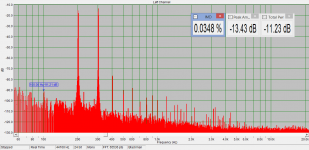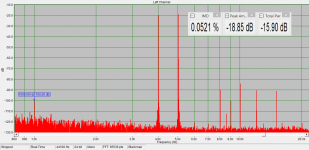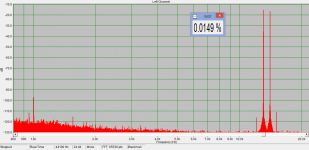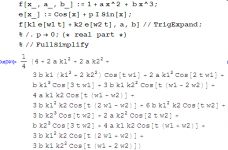Yes and no. The B&K preamps are OK but the measuring amp is a real limitation. I have had several and I currently have a 2609. Problem is that it is noisy and the user interface is nearly impossible to figure out. I modified it to get direct access to the mike preamp. This helps but underscores the focus on measurement microphones is amplitude.
A couple of technical points that seem to be sometimes lost here. First, both loudspeaker drivers and microphones operate in a Class A mode. That means that there should not be any random nonlinear distortion, and at the lowest operating levels they should approximate perfect. The devices' departure from this, both the speaker and the microphone should be predictable over a considerable range of amplitude from just one good measurement at a specific level. Therefore, if you measure 1% harmonic, or IM distortion at a specific level, and can break up the distortion sum into its components, (best done with harmonic distortion for simplicity) then you can closely predict the distortion components at both higher and at lower SPL levels with reasonable accuracy. The rule however is that 2'nd harmonic will track exactly with level, but 3'rd harmonic will rise as the square of the level. Higher harmonics have an even steeper slope, but normally we can discard them for this measurement. IM is much more complex, and hard to read. Multi-tone IM with 3 or more frequencies is even more difficult, but will give an added 'triple beat' distortion that is twice the level as any of the other two tone components. Even more than 3 frequencies may be interesting, but it will not necessarily reveal any more information in an open loop (speaker driver) or microphone system as we normally find it designed. What I mean here is that a simple jfet follower, the usual main component of a measurement microphone system, has a very predictable distortion pattern that follows the rules of class A operation. More complex circuits COULD have problems, so some studio mikes might deviate from easy prediction. Really cheap mikes usually have really cheap electronics, with very low voltages to power them. They WILL have potential problems, and that is what PMA appears to have run in to. However a B&K measurement mike capsule used with a separate microphone preamp, should have almost no significant distortion at normal working levels of 100dB or so, and even predictably less at lower levels, and this should be enough for the speaker measurements that we are looking for.
A studio mike might work as well, IF the limits of mike are respected. The capsules are usually not designed for extreme levels of about 120dB or higher, and can even have some measurable distortion at 100dB, but it should be low (hopefully) enough to make a RELATIVE MEASUREMENT between different speaker drives, i.e. current, voltage, or JN.
It must be remembered that CHEAP MIKES may or may not be effective for measuring, but still OK for bird calls, etc. It depends on their design, and the good luck of designing an exceptional circuit to go with it. If in doubt, don't trust a cheap mike.
A studio mike might work as well, IF the limits of mike are respected. The capsules are usually not designed for extreme levels of about 120dB or higher, and can even have some measurable distortion at 100dB, but it should be low (hopefully) enough to make a RELATIVE MEASUREMENT between different speaker drives, i.e. current, voltage, or JN.
It must be remembered that CHEAP MIKES may or may not be effective for measuring, but still OK for bird calls, etc. It depends on their design, and the good luck of designing an exceptional circuit to go with it. If in doubt, don't trust a cheap mike.
Last edited:
More on two-source method of measurement of microphone distortion. Results for 200+300Hz, 4+5kHz and 13+14kHz are shown. We can see that the difference tone is always 80dB or more below the test tone, even for 200+300Hz test. The plots are messed up with speaker distortion above the test tone frequencies, as expected. I think that -80dB distortion is enough for comparison of distortion under voltage, current or JN drive.
One can also see that i the 4+5kHz test, tweeter distortion is below 0.1% ....
One can also see that i the 4+5kHz test, tweeter distortion is below 0.1% ....
Attachments
Last edited:
BTW, just thinking out loud, would it be possible to increase/decrease the "GND-side" bias voltage to obtain different sensitivities, that is, would a DC bias actually add to the electret polarization and would doing so spoil the JFET OP in your circuit as-is, given that it is leakage biased?EDIT - Not shown is the third wire (case) it is grounded.
Yes and no. The B&K preamps are OK but the measuring amp is a real limitation. I have had several and I currently have a 2609. Problem is that it is noisy and the user interface is nearly impossible to figure out. I modified it to get direct access to the mike preamp. This helps but underscores the focus on measurement microphones is amplitude.
The 2609 is only specified with distortion <0.1% (1kHz) while the 2610 and 2636 are below 0.01% at 1kHz and <0.1% at 50 kHz.
I´ve to look for the precise data but have measured the 2636 around 0.005% for THD + N at 1 kHz, possibly even lower but of course depending on the actual input voltage (and attenuater settings).
BTW, just thinking out loud, would it be possible to increase/decrease the "GND-side" bias voltage to obtain different sensitivities, that is, would a DC bias actually add to the electret polarization and would doing so spoil the JFET OP in your circuit as-is, given that it is leakage biased?
This works (IIRC I tried it) but the equivalent polarizing voltage was high and 50 or 60V was needed to do much and I felt this was mainly a curiosity. In fact you can use the capsule as an input coupling cap for direct electrical measurement that's how I measured the THD (~0.02% @3.5Vrms). I never got around to trying mixed acoustic and electrical stimulation to see if any interesting phenomena turned up (like even the possibility of distortion cancellation) nor did I try to see if the reciprocity worked. As I mentioned you can tape two omni capsules together face to face and measure the correlation of the noise but I don't know enough theory to put any real use to this.
I have lost a lot of the measurements I made. I did a complete teardown of a WM-61 capsule and tried to measure everything (the capacitance was right on 10pF).
If it matters remember a normal condensor mic and a back electret are opposite in phase with applied acoustic pressure.
EDIT - The stacked DIP PV arrays (~14V/package) make a very nice (safe) HV supply for capsule bias experiments. I built a complete 1" mic running on 5mA from a 9V battery with an all FET Schoeps circuit (a real "Pass Labs" project). 😉
Last edited:
More on two-source method of measurement of microphone distortion. Results for 200+300Hz, 4+5kHz and 13+14kHz are shown. We can see that the difference tone is always 80dB or more below the test tone, even for 200+300Hz test. The plots are messed up with speaker distortion above the test tone frequencies, as expected. I think that -80dB distortion is enough for comparison of distortion under voltage, current or JN drive.
One can also see that i the 4+5kHz test, tweeter distortion is below 0.1% ....
Yep. Should do just fine for YOU. I would like to mess around with drivers also... so, what mic are you using?
JC, are you saying that the distortion is pretty much a straight line to zero as SPL is decreased? So, if we know the distortion at a given SPL, we can calc what it will be at a lower SPL accurately?
If we know the thd is 3% at 130db spl, you can tell me what spl the mic will produce 0.1%
?
THx-RNMarsh
Last edited:
If we know the thd is 3% at 130db spl, you can tell me what spl the mic will produce 0.1%
The graphs are in the papers posted, it roughly is the same as 2nd and 3rd order intercept concepts from RF. The math is in the ITT Handbook (you do have a copy?). 😀
The 2609 is only specified with distortion <0.1% (1kHz) while the 2610 and 2636 are below 0.01% at 1kHz and <0.1% at 50 kHz.
I´ve to look for the precise data but have measured the 2636 around 0.005% for THD + N at 1 kHz, possibly even lower but of course depending on the actual input voltage (and attenuater settings).
The 2609 is less than .01% distortion at certain settings but the noise is higher at all the settings I tried than the preamp alone. The bigger measuring amps were more confounding to use. Too many options for the settings.
No. I don't have a copy
You just take 1+A*x**2+B*x**3 (where A and B are small) and put the sum of two sine waves in for x and tediously expand it using all those trig identities you forgot or use Euler's formula (recommended).
It is fairly easy Richard, once recognized. Yes they teach it in class as well, but if you know the harmonic that is absolutely dominant, then you can predict lower levels with reasonable accuracy. For example, if you had 3% 2nd harmonic distortion at 130dB SPL, then at 110 dB you should have 0.3%. However if the distortion was predominantly 3rd harmonic at 3%, at 130dB SPL then you would have only 0.03% 3rd harmonic at 110dB, BUT then second harmonic might be dominant and effect the measurement, because second harmonic does not drop as fast as 3'rd, but it is just as predictable. One possible problem with instruments with passive meters attached is that the DIODES driving the meter might effect the distortion measurement. I might guess that Demian is finding that a problem. Oh, by the way Demian, any luck finding those other mike preamps?
OK, but where have these efforts ended??
Originally it was about speaker distortion under voltage and current drive, and alternatively JN drive. I do not see many people contributing real results. However, I can see many opinions and "advices". It is always easier to give the advices than to contribute with real experimental work, right? I have known that for all of my career 😉. The DIY is no exception.
Originally it was about speaker distortion under voltage and current drive, and alternatively JN drive. I do not see many people contributing real results. However, I can see many opinions and "advices". It is always easier to give the advices than to contribute with real experimental work, right? I have known that for all of my career 😉. The DIY is no exception.
Yes, I noticed that once I typed it. However, PMA and others were floundering in obscure microphone problems with a test that THEY wanted to do. My criticisms finally went to helpful hints as to how they can get out of their problems. I made MY measurements 45 or so years ago and I don't necessarily want to get out my microphone to do the test that others wanted to be made here, myself. Let's hope that somebody else can make this speaker test and then we can move forward.
You just take 1+A*x**2+B*x**3 (where A and B are small) and put the sum of two sine waves in for x and tediously expand it using all those trig identities you forgot or use Euler's formula (recommended).
Here you go ...
Attachments
That's cheating, I think I gave the gain vs input but any of the symbolic packages gets the answer for any of these problems easily.
Yup - I make fewer mistakes by doing the grunt work mechanically. Although with this ancient version of MM re-arranging the results to be intelligible is left as an exercise for the user.
Anyway, the dependence of the various components on the levels of the sinusoids is clear.
Anyway, the dependence of the various components on the levels of the sinusoids is clear.
- Status
- Not open for further replies.
- Home
- Member Areas
- The Lounge
- John Curl's Blowtorch preamplifier part III



